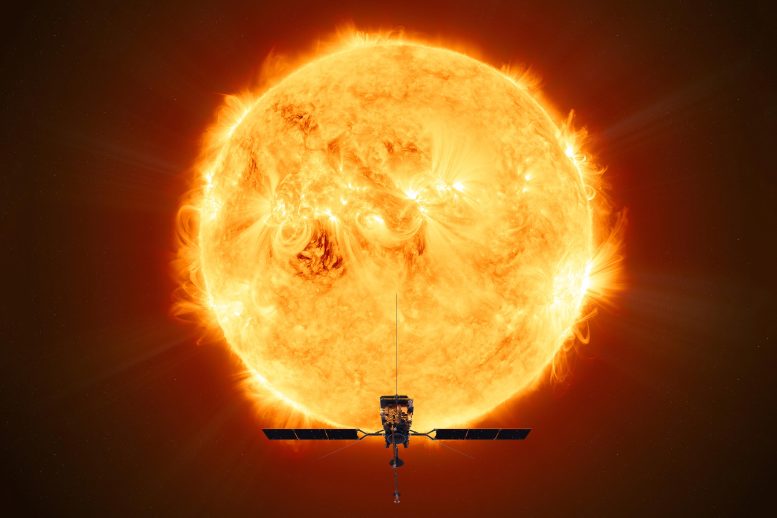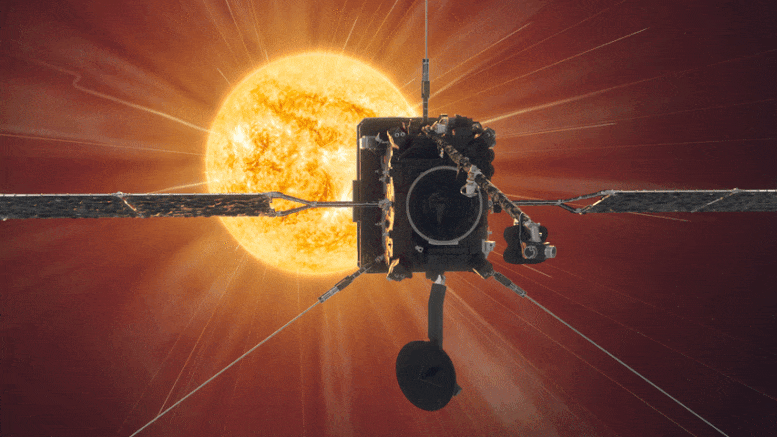
유럽 우주국(European Space Agency)의 태양 궤도선 애니메이션. 크레딧: ESA/Medialab
최신 Solar Orbiter 이미지는 전례 없는 세부 사항으로 전체 태양을 보여줍니다. 2022년 3월 7일 우주선이 지구와 태양 사이를 직접 통과하고 있을 때 촬영되었습니다.
EUI(Extreme Ultraviolet Imager)로 캡처한 이미지 중 하나는 전체 태양 디스크와 외부 대기인 코로나의 고해상도 이미지입니다.
SPICE(Spectral Imaging of the Coronal Environment) 기기로 촬영한 또 다른 이미지는 50년 만에 처음으로 완전한 태양 이미지를 나타내며 수소 가스에서 방출되는 자외선의 라이만 베타 파장을 따라 촬영한 최고의 이미지입니다.
이 이미지는 태양 궤도선이 우리 세계와 모성 사이의 중간인 약 7,500만 킬로미터 떨어져 있을 때 촬영되었습니다. EUI의 고해상도 망원경은 가까운 거리에서 전체 태양을 덮기 위해 25개의 개별 이미지 모자이크가 필요한 높은 공간 해상도로 이미지를 캡처합니다. 하나하나 촬영한 전체 이미지는 우주선이 한 부분에서 다음 부분으로 향하는 데 걸리는 시간을 포함하여 각 부분에 약 10분이 걸리기 때문에 4시간이 넘는 기간 동안 촬영되었습니다.
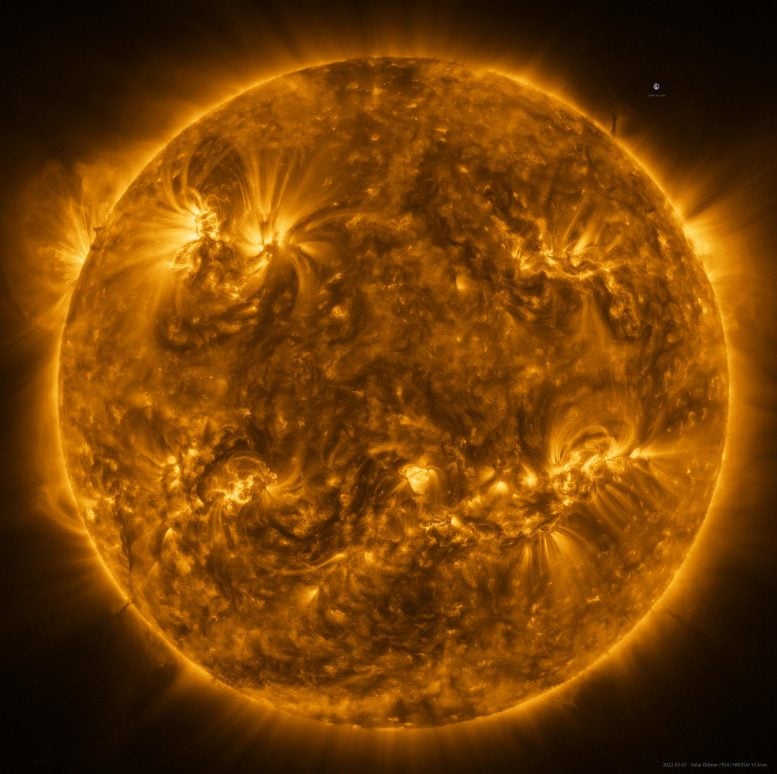
태양 궤도선이 약 7,500만km 거리에서 극자외선으로 본 태양. 이 이미지는 2022년 3월 7일 EUI(자외선 영상 기기) 고해상도 망원경으로 촬영한 25개의 개별 이미지를 모자이크한 것입니다. 이 이미지는 전자기 스펙트럼의 극자외선 영역에서 17나노미터의 파장으로 촬영되어 약 섭씨 100만 도의 온도를 가진 태양의 상부 대기인 코로나를 드러냅니다. 2시 위치에 있는 저울의 지구 이미지도 포함되어 있습니다. 제공: ESA 및 NASA/Solar Orbiter/EUI 팀; 데이터 처리: E. Kraaikamp(ROB)
전체적으로, 최종 이미지 9148 x 9112 픽셀 격자에 8300만 픽셀 이상을 포함합니다. 비교를 위해 이 이미지는 4K TV 화면이 표시할 수 있는 것보다 10배 더 나은 해상도를 가지고 있습니다.
EUI는 전자기 스펙트럼의 극자외선 영역에서 17나노미터 파장의 태양을 묘사합니다. 이것은 약 100만도의 온도를 가진 태양의 상부 대기인 코로나를 드러냅니다.[{” attribute=””>Celsius.
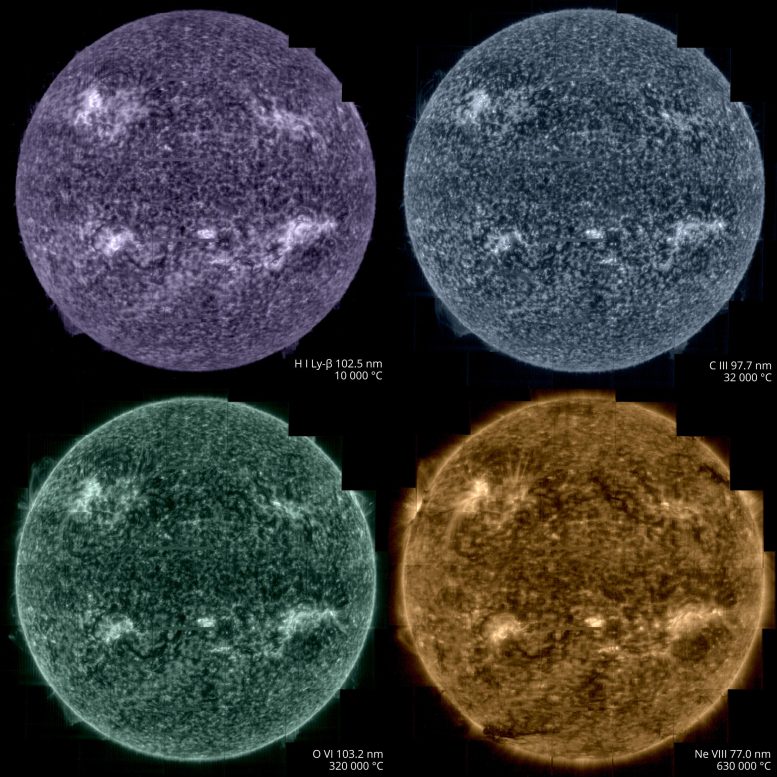
Solar Orbiter took images of the Sun on March 7, from a distance of roughly 75 million kilometres, using its Spectral Imaging of the Coronal Environment (SPICE) instrument. SPICE takes simultaneous “spectral images” at several different wavelengths of the extreme ultraviolet spectrum by scanning its spectrometer slit across a region on the Sun. The different wavelengths recorded correspond to different layers in the Sun’s lower atmosphere. Purple corresponds to hydrogen gas at a temperature of 10,000°C, blue to carbon at 32,000°C, green to oxygen at 320,000°C, yellow to neon at 630,000°C. Each full-Sun image is made up of a mosaic of 25 individual scans. It represents the best full Sun image taken at the Lyman beta wavelength of ultraviolet light that is emitted by hydrogen gas. Credit: ESA & NASA/Solar Orbiter/SPICE team; Data processing: G. Pelouze (IAS)
At the 2 o’clock (near the image of the Earth for scale) and 8 o’clock positions on the edges of the Sun, dark filaments can be seen projecting away from the surface. These ‘prominences’ are prone to erupt, throwing huge quantities of coronal gas into space and creating ‘space weather’ storms.
In addition to EUI, the SPICE instrument was also recording data during the crossing. These too needed to be pieced together as a mosaic.
SPICE is designed to trace the layers in the Sun’s atmosphere from the corona, down to a layer known as the chromosphere, getting closer to the surface. The instrument does this by looking at the different wavelengths of extreme ultraviolet light that come from different atoms.
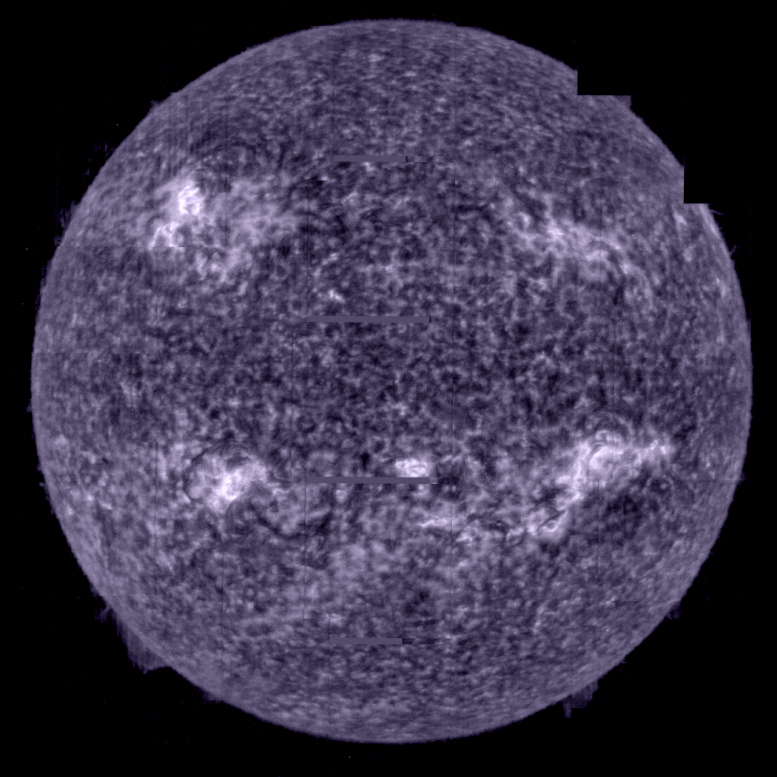
Taking the Sun’s temperature. Credit: ESA & NASA/Solar Orbiter/SPICE team; Data processing: G. Pelouze (IAS)
In the SPICE sequence of images purple corresponds to hydrogen gas at a temperature of 10,000°C, blue to carbon at 32,000°C, green to oxygen at 320,000°C, yellow to neon at 630,000°C.
This will allow solar physicists to trace the extraordinarily powerful eruptions that take place in the corona down through the lower atmospheric layers. It will also allow them to study one of the most puzzling observations about the Sun: how the temperature is rising through the ascending atmospheric layers.
Usually the temperature drops as you move away from a hot object. But above the Sun, the corona reaches a million degrees Celsius whereas the surface is only about 5000°C. Investigating this mystery is one of the key scientific objectives of Solar Orbiter.
The images were taken on 7 March, precisely when Solar Orbiter crossed the Sun-Earth line, so the images can be compared with Earth-bound solar instruments and cross-calibrated. This will make it easier to compare results from different instruments and observatories in future.
On March 26, Solar Orbiter reaches another mission milestone: its first close perihelion. The spacecraft is now inside the orbit of Mercury, the inner planet, taking the highest resolution images of the Sun it can take. It is also recording data on the solar wind of particles that flows outwards from the Sun.
And this is just the start, over the coming years the spacecraft will repeatedly fly this close to the Sun. It will also gradually raise its orientation to view the Sun’s previously unobserved polar regions.
Solar Orbiter is a space mission of international collaboration between ESA and NASA.

“음악 팬. 매우 겸손한 탐험가. 분석가. 여행 괴짜. 익스트림 TV 전문가. 게이머.”




